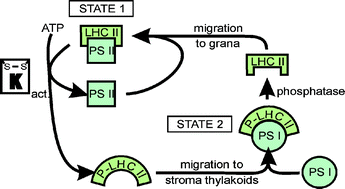Functional flexibility and acclimation of the thylakoid membrane†
Abstract
Light is an elusive substrate for the function of photosynthetic light reactions of photosynthesis in the thylakoid membrane. Therefore structural and functional dynamics, which occur in the timescale from seconds to several days, are required both at low and high light conditions. The best characterized short-time regulation mechanism at low light is a rapid state transition, resulting in higher absorption cross section of PSI at the expense of PSII. If the low light conditions continue, activation of the lhcb-genes and synthesis of the light-harvesting proteins will occur to optimize the functions of PSII and PSI. At high light, the transition to state 2 is completely inhibited, but the feedback de-excitation of absorbed energy as heat, known as the energy-dependent quenching (qE), is rapidly set up. It requires, at least, the ΔpH-dependent activation of violaxanthin de-epoxidase and involvement of the PsbS protein. Another crucial mechanism for protection against the high light stress is the PSII repair cycle. Furthermore, the water–water cycle, cyclic electron transfer around PSI and chlororespiration are important means induced under high irradiation, functioning mainly to avoid an excess production of reactive oxygen species.

- This article is part of the themed collection: In honour of James Barber

 Please wait while we load your content...
Please wait while we load your content...